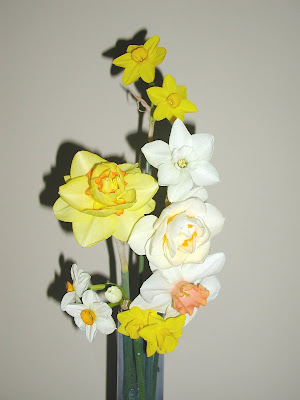Dicentra spectablis (Bleeding Heart) is another one of the perennials I think every garden should have. It is one of the first large perennials to begin blooming in the spring. Individual flowers are heart shaped and are borne on foot long horizontal stems, about a dozen flowers per stem. Each heart shaped flower has a tiny white droplet hanging from the bottom of it, hence the “bleeding heart”. Each plant will produce dozens of these wands of flowers over several weeks beginning in May and lasting into June. The mature plant creates a stunning tiered effect that is delicate but at the same time imposing. There is a pure white form as well as the usual pink form, and to me they are equally beautiful.
 Pink bleeding hearts with Brunnera, tulips and white daffodils.
Pink bleeding hearts with Brunnera, tulips and white daffodils.I grew
Dicentra spectablis for years before reading that they make good cut flowers. The only trick is to lightly scrape the bottom couple inches of the stem with a knife or your clippers after cutting it. This will help the stem take up water. I think the white is a little easier to combine with other colors than the pink, which is a really 'cold' pink. It looks great with purples and blues but clashes with many of the warmer pinks that are common in the spring.
 White bleeding heart with Virginia bluebells, 'Angelique' tulips and daffodils.
White bleeding heart with Virginia bluebells, 'Angelique' tulips and daffodils.Bleeding hearts are plants for partial shade. They will survive in deep shade but really look their best in either light dappled shade cast by trees like locusts or dogwoods, or beneath trees limbed up high enough to allow direct sun in the morning and afternoon. They can even tolerate full sun but will tend to burn up and go dormant sooner in the summer. They prefer the shade lover’s evenly moist, humus rich soil, but will grow pretty well in any decently amended garden soil you have.
 White bleeding heart with yellow Leopard's Bane and 'Spring Green' tulips.
White bleeding heart with yellow Leopard's Bane and 'Spring Green' tulips.Bleeding hearts sometimes self seed a bit, but never enough to be a pest. If new plants do appear, though, there will always be people waiting to take them. If you are growing both pink and white varieties, you can easily tell the white from the pink even when they are not in bloom. The white plants emerge bright green and mature into a medium green. The pink plants emerge a pinkish green and the leaves mature to a darker bluish green than the white form.
Pink bleeding hearts look terrific with blue flowers. The most classic combination is with
Brunnera macrophylla. The
Brunnera has large heart shaped leaves, true blue forget-me-not like flowers and it blooms at exactly the same time as the bleeding heart. You can also just combine them with forget-me-nots or even grape hyacinths. The white form looks nice with almost any other color, and planted alongside blue hostas is a classic choice for the all-white, semi-shady garden.
Dicentra spectablis is an easy plant to find, either packaged bare-root in early spring, or in containers at garden centers and the Farmer’s Market. Even large plants can be moved quite easily, especially if it is done in early spring before growth really gets going.
Given all their great features, it is easy to forgive the bleeding heart its one fault - it tends to go dormant (that is, the foliage dies back) in midsummer. How early this happens seems to vary some from year to year depending on heat, moisture and how much sun the plant is getting. In my gardens it usually happens by late July or early August.





































